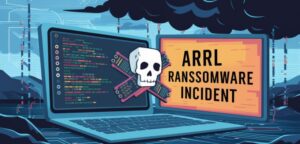
|
Getting your Trinity Audio player ready... |
The process of protecting networks, computers, servers, mobile devices, electronic systems, and data from malicious attacks is known as cybersecurity. It is also referred to as electronic information security or information technology security. The term can be categorized into a few common categories and is used in various contexts, including business and mobile computing.
The process of safeguarding a computer network against trespassers, be they malevolent actors or malicious software, is known as network security.
- Application security aims to protect devices and software from attacks. The data that an application is meant to secure could be accessed through compromise. Effective security starts long before a program or device is used, during the design phase.
- Information security measures safeguard Data privacy and integrity during storage and transmission.
- Decision-making and handling procedures for managing and safeguarding data assets are part of operational security. This encompasses the rights users have when they connect to a network as well as the policies that specify where and how data can be shared or stored.
- Disaster recovery and business continuity refer to an organization’s plans for handling a cyber-security incident or any other situation that results in the loss of data or operations. Policies for disaster recovery specify how an organization will restore data and operations to reach full operational capacity following an incident. The strategy an organization uses to try to function in the absence of specific resources is known as business continuity.
- End-user education targets the most erratic aspect of cyber-security: human behavior. Failure to adhere to recommended security practices can result in the unintentional introduction of a virus into an otherwise secure system. Encouraging users to remove dubious email attachments, avoid inserting unknown USB drives, and learn other crucial lessons is imperative for maintaining the security of any establishment.
The extent of the cyber threat
There is an increasing number of data breaches every year, and the global cyber threat is still evolving at a rapid pace. According to a RiskBased Security report, in just the first nine months of 2019, data breaches exposed an astounding 7.9 billion records. The number of records exposed during the same period in 2018 is less than half (112%) of this figure.
The majority of breaches occurred in the medical services, retail, and public sectors, and were caused by malevolent criminals. Because they gather financial and medical data, some of these industries are more attractive to cybercriminals; however, any company that uses a network can become the target of customer data breaches, corporate espionage, or customer attacks.
Global spending on cybersecurity solutions is inevitably rising as the threat posed by cyberspace is expected to continue growing in scope. According to Gartner, spending on cybersecurity will top $260 billion worldwide by 2026 and reach $188.3 billion in 2023. In response to the growing cyber threat, governments everywhere have released guidelines meant to assist businesses in putting into place efficient cyber-security procedures.
The National Institute of Standards and Technology (NIST) in the United States has developed a framework for cyber-security. To prevent malicious code from spreading and facilitate early detection, the framework suggests ongoing, real-time monitoring of all electronic resources.
Cybersecurity is a broad field that encompasses many academic fields. It is composed of eight primary pillars
Network security
The majority of attacks happen over networks, and network security solutions are made to recognize and stop these kinds of attacks. To enforce safe web use policies, these solutions include data and access controls like Data Loss Prevention (DLP), Identity Access Management (IAM), Network Access Control (NAC), and Next-Generation Firewall (NGFW) application controls.
Technologies for preventing advanced and multi-layered network threats include NGAV (Next-Gen Antivirus), Sandboxing, CDR (Content Disarm and Reconstruction), and IPS (Intrusion Prevention System). Technologies, like automated SOAR (Security Orchestration and Response), threat hunting, and network analytics, are also crucial.
Cloud Security
Cloud security is becoming more and more important as businesses use cloud computing. A cloud security strategy consists of cyber security tools, regulations, guidelines, and services that aid in defending against attacks an organization’s whole cloud deployment, including its infrastructure, data, and apps.
Even though a lot of cloud service providers provide security solutions, these are frequently insufficient to achieve enterprise-level security in the cloud. In cloud environments, additional third-party solutions are required to defend against targeted attacks and data breaches.
Endpoint Security
The zero-trust security model suggests enclosing data, wherever it may be, in micro-segments. Using endpoint security is one method for accomplishing that with a mobile workforce. By implementing data and network security controls, advanced threat prevention techniques like anti-phishing and anti-ransomware, and forensics-enabling technologies like endpoint detection and response (EDR) solutions, businesses can use endpoint security to safeguard end-user devices like desktops and laptops.
Mobile Security
Mobile devices, like tablets and smartphones, are frequently disregarded because they have access to company data. This puts businesses at risk from phishing, zero-day, malicious app, and instant messaging (IM) attacks. These attacks are thwarted by mobile security, which also guards against rooting and jailbreaking devices and operating systems. Businesses can make sure that only compliant mobile devices have access to corporate assets by combining this with an MDM (Mobile Device Management) solution.
IoT Security
While there are productivity benefits associated with using Internet of Things (IoT) devices, there are also new cyber threats that organizations must contend with. Threat actors look for susceptible devices that are unintentionally online for malicious purposes, like providing access to a corporate network or serving as a host for another bot in a global bot network.
These devices are safeguarded by IoT security through auto-segmentation to regulate network activity, device discovery and classification, and the use of IPS as a virtual patch to stop exploits against susceptible IoT devices. To stop exploits and runtime attacks, the device’s firmware may occasionally be enhanced with tiny agents.
Application Security
Threat actors target web applications just like they do anything else that is directly connected to the Internet. The top 10 threats to serious web application security vulnerabilities, like injection, invalid authentication, misconfiguration, and cross-site scripting, have been monitored by OWASP since 2007.
Applications can be secured to prevent the OWASP Top 10 attacks. Bot attacks and other malevolent interactions with applications and APIs are also stopped by application security. Apps will stay safe thanks to continuous learning, even when DevOps releases new material.
Zero Trust
The conventional security paradigm is perimeter-focused, erecting walls like a fortress around the priceless assets of an organization. Nevertheless, there are several problems with this strategy, including the possibility of insider threats and the network perimeter’s quick collapse.
A new security strategy is required when corporate assets are moved off-premises due to cloud adoption and remote work. Utilizing a more granular approach to security, zero trust safeguards specific resources by combining role-based access control enforcement, monitoring, and micro-segmentation.
Critical Infrastructure Security
Critical infrastructure organizations rely on networks, applications, systems, and digital assets that are protected by special security procedures and cybersecurity solutions (e.g., communications, dams, energy, the public sector, and transportation). Cyberattacks that target legacy systems, like SCADA (supervisory control and data acquisition) systems, have become more frequent targets for critical infrastructure. Although many of the cybersecurity techniques used by critical infrastructure organizations are similar to those used by other subcategories, they are frequently implemented differently.
Types of Cybersecurity Threats
1. Malware
Software designed to cause harm is known as malware. Malware also referred to as a virus, can infect a system just by opening the incorrect attachment or clicking on the incorrect link.
2. Ransomware
One kind of malware is ransomware. The distinction lies in the fact that ransomware compromises a network or pilfers private information, after which it demands a ransom—usually some kind of currency—to gain access to your systems.
3. Attacks by Phishing
Phishing is exactly what it seems. Hackers bait you in the hopes that you will bite, and when you do, they take advantage of your vulnerability to steal credit card numbers, passwords, and other private data. Phishing attacks typically take the shape of emails that appear authentic and entice you to respond.
4. Employing Social Engineering
Malicious human interaction is a component of social engineering. This is an instance of people flat-out lying to others and coercing them into disclosing personal information. These folks frequently get information from posts and profiles on social media.
5.SQL injection
An SQL (structured language query) injection is a type of cyber-attack used to take control of and steal data from a database. Cybercriminals exploit vulnerabilities in data-driven applications to insert malicious code into a database via a malicious SQL statement. This gives them access to the sensitive information contained in the database.
Cyber safety advice: protect yourself from online attacks
How can individuals and companies protect themselves from cyberattacks? Here are our top suggestions for online safety:
- Update your operating system and applications to take advantage of the most recent security patches.
- Make use of antivirus software: Security programs such as Kaspersky Total Security can identify and eliminate threats. For optimal protection, keep your software updated.
- Make sure your passwords are difficult to figure out by using strong passwords.
- Avoid opening email attachments from senders you are not familiar with because they might be malware-filled.
- Avoid clicking on links in emails from senders you are not familiar with or from unknown websites. This is a typical method of malware distribution.
- Refrain from connecting to insecure WiFi networks in public areas. These networks expose you to man-in-the-middle attacks.





